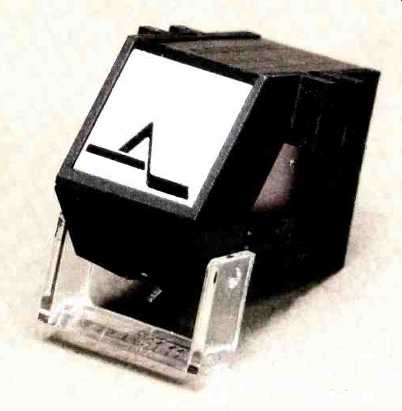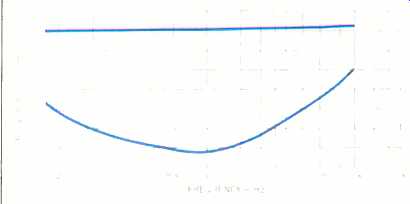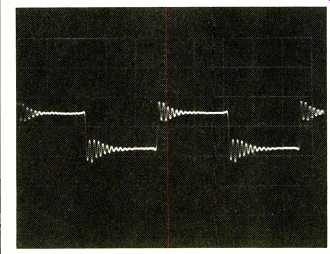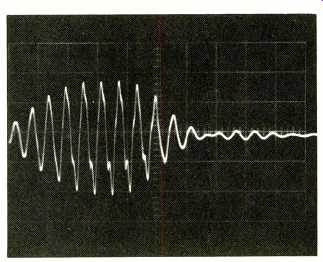
Manufacturer's Specifications:
Type: Moving magnet.
Stylus: Micro-Ridge.
Cantilever: Tapered aluminum tube.
Frequency Response: 10 Hz to 40 kHz.
Separation at 1 kHz: 25 dB or greater.
Vertical Tracking Force: 1.25 grams, ±0.25 gram.
Compliance: 50 x 10^-6 cm/dyne.
Output: 3.5 mV at 5 cm/S at 1 kHz.
Channel Balance: Within 1 dB at 1 kHz.
Inductance: 90 mH.
Load Resistance: 47 kilohms.
Load Capacitance: 100 pF.
Cartridge Mass: 5.5 grams.
Price: $100.
Company Address: P.O. Box 120, Harbor and Jackson Sts., Conneaut, Ohio 44030, USA.
The MF-100MR is the top of the line of cartridges currently offered by Astatic, a company that has been involved in sound reproduction since 1930. This magnetic cartridge is a patented "Moving Flux" type, made by the Mitachi Corporation of Japan. It uses a Micro-Ridge stylus mounted in a tapered aluminum cantilever which is supported by a front pivot system. Astatic says that in their design the cantilever is held at the one point where the effective mass of the stylus assembly is lowest. This is to help safeguard against any wandering motion of the pivot point with changes in frequency. It is claimed that these arrangements allow a re-creation of sound with a high level of fidelity to the original, without significant intermodulation distortion.
The MF-100MR uses a tiny magnet at the end of the cantilever tube; this magnet is positioned in the cartridge body in close proximity to a specially wound coil assembly.
As the stylus traces the record grooves, the magnet and its associated flux lines move, and that flux which intersects the coils generates an output voltage. As in moving-coil cartridges, the conversion of mechanical motion to an electrical signal is instantaneous, but unlike moving-coil cartridges, the MF-100MR has a high conversion efficiency, and no step-up transformers or pre-preamps are required.
I studied the stylus and cantilever under 100X magnification; the stylus appeared to be accurately mounted to the cantilever and was of good polish and shape. The cartridge came in a two-piece plastic container, along with mounting hardware to allow attachment to any universal tonearm conforming to EIA Standards. The usual screwdriver and stylus brush were included as well.
When this cartridge first reached me for review, its suggested retail price was $320. In the interim, the company has been sold. The new management has decided that, since they have large stocks of the MF-100MR but do not currently have a full dealer network, they will sell these cartridges factory direct, at $100 each.
Measurements
After measuring an inductance of 94 mH and a resistance of 1.6 kilohms, I mounted the MF-100MR in a Grace G-747 tonearm. The tonearm was then placed in its mount on a Denon DP-6000 turntable and the cartridge aligned with the aid of a Telarc Omnidisc. Measurements were made on both channels to assure accuracy, but only the left channel is reported unless there was significant variation. During the test period the ambient temperature was 72° F, ± 2° (22.2° C), and the relative humidity ranged from 40% to 60%. The following test records were used in making the measurements reported here: CBS STR-100, STR-112, CTC-300, CTC-310, and CTC-330 (the latter three from the company's recently issued Professional Series); Deutsches HiFi No. 2, and Shure TTR-103, TTR-110, TTR-115, and TTR-117.
The tracking force found to be optimum was 1.3 grams, and the optimum anti-skating force was 1.5 grams. For testing, a load resistance of 47 kilohms and a load capacitance of 100 pF were used.
The low-frequency arm/cartridge resonance resulted in a 7-dB rise at a frequency of 14 Hz. The combination of a 7-dB rise and a relatively high resonant frequency allowed the combination to track warped records with little problem.
Figure 1 shows the frequency response and channel separation of the MF-100MR, measured using the CBS CTC-310 test record. Response was within 2 dB from 20 Hz to 20 kHz. Separation at mid-frequencies was around 30 dB, reaching a high of 32 dB at 1 kHz. Separation over the entire audio spectrum was quite high, higher than that of most cartridges made a few years ago.
Figure 2 shows the response to a 1-kHz square-wave test signal obtained with the CTC-310 record. I used an expanded 'scope trace to measure an 8.4-µS rise-time, one of the fastest I have measured. There are several cycles of oscillations at a frequency of approximately 50 kHz, indicating underdamped resonance somewhere in the moving system, but this is of little concern since the oscillations are in the ultrasonic region. The extended high-frequency response of the cartridge is evident from its fast rise-time.
Figure 3 illustrates the tracking of the highest level of the 10.8-kHz pulsed sine wave on Shure's TTR-103 test record.
It is recorded at a peak velocity of 30 cm/S, and although there is visible distortion present, there is little evidence of amplitude compression or objectionable resonances.
Dynamic vertical compliance was 9 x 10-6 cm/dyne, while dynamic lateral compliance was 7 x 10^-6 cm/dyne.
Using the STR-100 test record, I found the output for the left channel to be 3 mV for a 5-cm/S lateral recorded velocity, with a channel balance of 0.5 dB or better. Lateral (+9 dB) IM distortion using CTC-310 (400/4000 Hz, 4-to-1) was: Left, 3%; right, 2.6%. With the STR-112 test record, vertical (+6 dB) IM distortion was: Left, 5%; right, 4.5%.
CTC-300 contains lateral- and vertical-polarity bands, and with it I found that the MF-100MR produces a positive signal on outward and upward groove excursions.

Fig. 1-Frequency response (top curve) and separation (bottom curve).
Test record is CBS CTC-310.

Fig. 2-Square-wave response. Test record is CBS CTC-310.

Fig. 3-Output for 10.8-kHz pulse test at 30 cm S, a very high recorded
level. Test record is Shure TTR-103.
The cartridge was able to track most of my test records with no distortion audible to my ears or visible on my oscilloscope. It tracked the highest vertical 300-Hz band of the Deutsches HiFi No. 2 test record, which is recorded at 55.4 microns (0.00554 cm) at 10.32 cm/S at 5.86 dB. It was also able to track the highest lateral level, which is recorded at 114 microns (0.0114 cm) at 21.50 cm/S at 12.10 dB.
Playing the mid-frequency trackability test of Shure's TTR 103 (an equal-amplitude mixture of 1,000 and 1,500 Hz), the MF-100MR was able to track at 31.5 cm/S (band 7, side one), the second-highest level of this signal on the disc. On the record's low-frequency trackability test, a 4:1 mixture of 400 and 4,000 Hz, the cartridge tracked the highest level band (band 8, side 2), recorded at 30 cm/S peak velocity.
There are five levels on Shure's Era IV Audio Obstacle Course (TTR-115), with level 5 being the hardest to track.
The cartridge was able to pass all of the individual instrument tests, level 4 of the harp and flute test, and level 5 of the bell and flute test. Shure's Era V Obstacle Course (TTR 117) contains six bands of a complex signal composed of 200 Hz, 2.1 kHz, and 17 kHz. The MF-100MR was able to track all bands of this disc without any audible mistracking or visible waveform distortion on my oscilloscope.
Some of the Professional Series test records from CBS contain recorded levels higher than those mentioned in the above tests. Using CTC-300, I found the cartridge's maxi mum lateral tracking ability to be 112.8 µm, the next-to-highest band. It could track the highest vertical band, re corded at 63.4 µm.
An X/Y plot of monophonic signals from several test re cords revealed good linearity and phasing between the two channels.
Use and Listening Tests
This cartridge was used to audition several digitally mastered and direct-to-disc recordings, using the same Denon turntable and Grace tonearm that had been used when making measurements. Toshiba-EMI records used were:
Super Strings, Tokyo String Ensemble, Kouichi Sugiyama conducting (LF-95010); Sgt. Pepper's Lonely Hearts Club, Jun Fukamachi (LF-95014), and 30 Years in 30 Minutes, Eiji Kitamura & All Stars (LF-95012). Other records used included: Beethoven's "Piano Sonata No. 23 in F Minor, Op. 57, Appassionata," Ikuyo Kamiya, piano (RCA RDC-4, JRL 1 1105); Ravel's "Quartet in F Major" and Bartók's "Quartet No. 3," Sequoia String Quartet (Delos DMS 3004); Stravinsky's "Firebird Suite- and Debussy's "Afternoon of a Faun," Los Angeles Philharmonic Orchestra, Erich Leinsdorf con ducting (Sheffield Lab 24); Chopin's "Sonata No. 3 in B Minor, Op. 58," Steven Gordon, pianist (Reference Recordings RR-5), and Ragtime Concert, Nexus (Umbrella UMB DD-2). Also used were the superb Opus 3 test records Nos. 1 and 2, Knud Jorgenson Jazz Trio (also Opus 3), Amanda McBroom's Dreaming (Gecko Records), and Caetano Veloso (Nonesuch 79127, digital).
This cartridge's sonic qualities could not be faulted. It performed well on all program material, superbly reproducing massed strings and voices, and it handled warped records as well as, or better than, most cartridges. Channel separation was above average, as were the localization and imaging of solos and instruments on the sound stage.
The MF-100MR's response is virtually flat over the audio range and extends considerably above it. As one would expect from its uniform response, it is a neutral-sounding cartridge, without the tizzy sound that one hears from cartridges with a rising high end. It has an even response over the midrange, bass that extends as low as material is recorded, and an unrestrained high end.
The MF-100MR is inexpensive, considering the level of quality, and if you are thinking of buying a new, high-quality cartridge, this one deserves to be considered.
-George Shellenberger
(adapted from Audio magazine, Sept. 1987)
= = = =